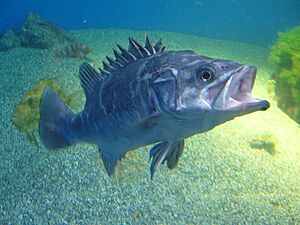Atlantic wreckfish facts for kids
Quick facts for kids Atlantic wreckfish |
|
|---|---|
 |
|
| Conservation status | |
| Scientific classification | |
| Synonyms | |
|
The Atlantic wreckfish (Polyprion americanus) is a large, strong fish. People also call it the stone bass or bass groper. It lives in the deep parts of the ocean, near the bottom. This fish travels long distances in the ocean. You can find it in the Atlantic, Pacific, and Indian Oceans.
Contents
About the Atlantic Wreckfish
The Atlantic wreckfish is a very big fish. It has a thick body and a large head. Its lower jaw sticks out a bit.
Body Features
This fish has two dorsal fins on its back that are joined together. The first dorsal fin has 11 stiff spines. The second one has 12 soft rays. Its anal fin (on its belly) has a short base and three strong spines. The caudal fin (tail fin) is wide and square.
Skin and Color
The wreckfish's body is covered with small, firm scales. These scales even go up onto the base of its dorsal and anal fins. It has a big mouth and large eyes. The bony plate covering its gills (called the operculum) has a spiny edge. It also has a thick bone that ends in a spine near its eye.
The back and sides of the wreckfish are dark brown. They have darker spots and blotches. Its belly is yellowish. Some people say they are bluish-grey on top with a shiny silver underside. Their fins are dark brown or blackish.
Size of the Wreckfish
Atlantic wreckfish can grow very large. They can be up to 210 centimeters (about 7 feet) long. The heaviest one ever recorded weighed 100 kilograms (about 220 pounds).
Where Wreckfish Live
The Atlantic wreckfish lives in many different parts of the world. But their populations are spread out.
Ocean Locations
- Eastern Atlantic Ocean: From Norway all the way down to South Africa. They are also found in the Mediterranean Sea. This includes islands like the Macaronesian Islands and Tristan da Cunha.
- Western Atlantic Ocean: From Newfoundland in Canada down to Argentina in South America.
- Western Indian Ocean: Around islands like Île Saint-Paul and Île Amsterdam.
- Southwestern Pacific Ocean: Around New Zealand.
- Southern Australia: From north of Perth, Western Australia to Fraser Island in Queensland. This also includes Tasmania.
Wreckfish Life and Habits
Adult Atlantic wreckfish like to live in and around caves. They also live near rocky areas and shipwrecks. This is why they are called "wreckfish"!
Deep Sea Home
These adult fish live in very deep water. They have been found at depths between 200 and 600 feet. Usually, they live alone. But in the summer, adults gather together to breed.
Young Wreckfish Behavior
Young wreckfish swim in groups called shoals. This helps protect them from bigger fish that might try to eat them. They hunt small fish in the middle of the water. Once they grow to about 50-75 centimeters (20-30 inches) long, they start to live alone. Then they look for their own space on the ocean floor.
Diet and Lifespan
Scientists think Atlantic wreckfish can live for a very long time, possibly up to 90 years! They mostly eat fish, squid, and cuttlefish that live on the bottom. They also eat crabs, lobsters, and octopuses. They are "opportunistic" eaters. This means they will eat whatever food they can find. For example, a camera once filmed a wreckfish eating a whole shark that was feeding on a dead swordfish!
Natural Enemies
Adult wreckfish do not have any known predators. This means no other animals hunt them for food. However, young wreckfish can be eaten by large bony fishes or sharks.
Wreckfish and People
The Atlantic wreckfish is a valuable fish for fishing. People like to eat it in some parts of the world.
As Food
Large wreckfish are often cut into steaks. Smaller fish are made into fillets or baked whole. In North and South America, you can buy wreckfish frozen in stores. You can also find it fresh at fish counters.
How They Are Caught
Fishermen catch wreckfish using different methods. They use large nets called trawler nets. They also use long lines with many hooks. Sometimes, they use gill nets. Small-scale fishermen might even catch them with a rod and line.
Conservation Status
The IUCN (International Union for Conservation of Nature) studies how many animals are left. For the Atlantic wreckfish, they say there is "data deficient" information. This means they don't have enough data to know if the fish is in danger worldwide. However, some groups of wreckfish, like those in the Mediterranean Sea, are thought to be at higher risk.



